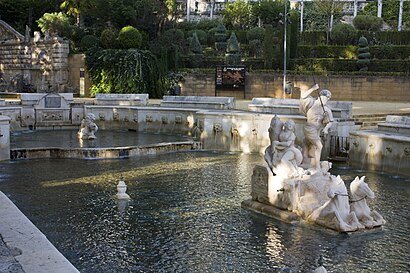This monumental complex has been declared a Cultural Heritage Site since 1985, and it is considered one of the most emblematic corners of the city, particularly appreciated for its beauty and historical symbolism. In fact, the Cultural Route portal included it among the ten most beautiful fountains in Spain that one must visit.
Etymology
Its name has a historical background dating back to the events of 1341, when King Alfonso XI camped in the area during the reconquest of Priego. It was in that same year that the city definitively passed into Castilian hands after the victory over the Muslims, a crucial milestone in the history of the city and the region.
History
The Fuente del Rey is supplied by the historic Fuente de la Salud, a monumental structure built in the 16th century, which, as its name indicates, was dedicated to the Virgin of Health. This fountain also holds historical significance, as the statue of the Virgin of Health is located at the center of the fountain wall.
Over the centuries, the fountain underwent several modifications, especially since the 16th century, in order to better harness the waters of the spring that supply it. However, it was in 1802 when the Council of Castile granted the license for its definitive construction, entrusted to architect Remigio del Mármol. The work was completed in 1803, and the fountain has endured as one of the most beloved monuments in Priego.
Between 2017 and 2019, significant restoration work was carried out by restorer Manuel Jiménez Pedrajas, with support from the Diputación of Córdoba, to preserve this precious heritage.
Architecture
The Fuente del Rey is one of the largest and most majestic fountains in the region, with 139 jets of water flowing from its structure, many of which are adorned with stone masks of ghostly faces. The fountain consists of three ponds arranged at different levels, whose elongated shapes and curved outlines offer an aesthetic characterized by elegance and symmetry. Additionally, the fountain is surrounded by benches that invite rest and contemplation.
In the first pond, a sculpture depicting a lion and a serpent fighting offers a fascinating contrast, and it is attributed to the sculptor José Álvarez Cubero, known for his neoclassical style. In the second pond, Neptune and Amphitrite ride on a chariot drawn by horses emerging from the water, a work by Remigio del Mármol that stands out for its detailed composition.
The water flows from one pond to another through a waterfall, adding dynamism to the monumental ensemble, ending in a Clergy mask, whose design contributes to the decorative richness of the place.



















